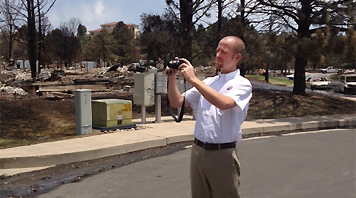|
RMIIA News Releases7951 E. Maplewood Avenue, Suite 110 Contact: Carole Walker, Executive Director Last Week's Tornado and Hail Add Up to $147 million in Estimated Insurance Damage—Making it Colorado's Most Costly Tornado and the 4th Most Expensive Insured Disaster. May 27, 2008 – This week residents in Windsor and surrounding communities are starting the process of repairing and rebuilding their homes, as they begin filing claims and meeting with insurance adjusters. Based on preliminary estimates the damage from the hail, wind and tornadoes are adding up to an estimated 20,000 claims and $147 million in insured damage to cars and homes from last Thursday's fierce storm. The estimated 8,000 property claims range from glass and roof damage to homes ripped from their foundations and completely destroyed from the force of the tornado. The estimated 12,000 auto claims range from everything to hail dents on cars to totaled vehicles. Homeowners insurance covers damage from tornadoes, wind and hail, while damage to vehicles is covered if you carry comprehensive insurance on your auto policy. “It is common for Colorado to get hit with hundred million dollar hail storms because they can cause damage to such a large area—pummeling thousands of cars and homes in a matter of minutes,” says Carole Walker, Executive Director of the Rocky Mountain Insurance Information Association. “However, historically tornadoes haven't caused this amount of costly damage in Colorado because they have touched down in less populated areas. Unfortunately, this time residents of Weld County were caught in the path of a devastating storm.” Prior to this storm, all of Colorado's most costly disasters occurred in the Denver-metro area (which makes sense, because that's where the largest concentration of property in the state is located). Previously, Colorado's most costly tornado caused an estimated $20 million in damages to Limon on June 6, 1990. Colorado's 10 Most Costly Storms:
As residents begin the claims process here's some answers to common questions: How Does the Claims Process Work? If you find other damage, you can “reopen” the claim and file for an additional amount. Most policies require claims to be filed within one year from the date of disaster. When both the structure of your home and personal belongings are damaged, you generally receive two separate checks from your insurance company, one for each category of damage. How Do I Select a Contractor? Don't become a victim of disaster fraud. After a natural disaster, professionals often go from door-to-door in damaged neighborhoods, offering clean up or repair services. Many of these business people are reputable. Others are not. Contractor Checklist:
What About My Stuff? Most companies provide coverage for 50% to 70% of the amount of insurance you have on the structure of your home. So if you have $100,000 worth of insurance on the structure of your home, you would have between $50,000 to $70,000 worth of coverage for your belongings. How Do I Get By While My Home is Repaired or Rebuilt? For more consumer information on insurance topics logon to www.rmiia.org. ### Rocky Mountain Insurance Information Association is a non-profit consumer information organization. Affiliated with the Insurance Information Institute, RMIIA has been serving consumers and the media since 1952. |
|
303-790-0216 • 800-355-9524 • Contact Us • Legal Notice, Disclaimer & Terms of Use
Home • About RMIIA • News Room • P&C Insurance Industry • Auto • Homeowners • Business • Catastrophes • Agent Resources • Events & Education • Brochures

